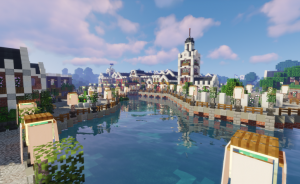| Please make sure your email address matches on the wiki and website as we'll be migrating to PCB logins in the near future. |
Tulpfloerdam
Tulpfloerdam, officially know as "Het Koninkrijk van Tulpfloerdam" or "The Kingdom of Tulpfloerdam", is a city-state nation located in the Northern part of the 1.15 map. Tulpfloerdam was the 3rd city on the 1.15 map to gain warp status (Following Montmorency and applying for warp the same day as Dixieville). The city is a Dutch city with heavy inspiration from Amsterdam, Haarlem, and Den Haag (The Hague).
History
In February of 1632, Dutch explorers were venturing through what is now modern day Dixieville and towards Titania and Eire. These explorers had faced many hardships crossing the swamplands/wetlands of now a days western Cascadia. Eventually, these men found a small deciduous forest sandwiched in between Mountains, Swamp, Dark Oak Forests, and Plains. The valleys of this forest had many rivers and small mountains. In the heart of this forest lies a lake, abundant with flowers. This gave the forest the name it knows today, "Woudbloemen" or "Forest Flowers".
Beginnings
After finding the shallow and flat shoreline perfect for agriculture, these settlers set up a resting camp for anyone else who passed through the land. Little did the Dutchmen know, the river that feeds the lake has incredibly violent flooding periods. Every 20 years, water levels rise higher than usual. These explorers landed themselves at the 20 year interval. Come mid April and the lake breached the shore, washing away and flooding the settlement they had made. These Dutchmen refused to leave this lake valley, so they built a dam that they would use to regulate the water flow into the lake.
Early Life
Once the dam was built, the lake was finally safe from future floods. These men had sent letters back to the mainland Netherlands in hopes they could send women over to start a growing population. Women arrived the following year, along with animals, seeds, tulip bulbs, and letters from the king and families. Small houses were rebuilt in the same location as the previous houses that were washed away. The population boomed from just 12 men to about 75-90 people in 1634. By the year 1640, the population was already at 600.
Cityhood
As this settlement continued to grow, so did its autonomy. The people had no name to call this place and yet were a major part in travel in the northern world. People petitioned to name the city "Woudbloemen" after the forest, but another very strong candidate was creeping up. This new name was "Tulpenbloemdamme", which translated to English would mean "The Dam of the Tulip Flowers". A community poll was made and Tulpenbloemdamme won by a small lead. Thus, on May 28, 1653, the City of Tulpenbloemdamme was established with Thijs Meijer being the first mayor of the city.
The Kingdom of Tarlia
This quite town, nestled in the hills of the Woudbloemen, had changed very little. After 3 to 4 generations of Tulpen citizens, the name went from "Tulpenbloemdamme" to something closer to what you hear nowadays, "Tulpefloerdamme". The city of Tulips would be forever changed after being captured by a bigger kingdom. The Kingdom of Tarlia marched their way through the hills and valleys of the Woudbloemen, eventually reaching Tulpefloerdamme. The Tarlish military came through, ransacking the city and killing innocent lives. The current mayor was in shock to see his city and his people die in front of him. As quick as possible, mayor Jean van Derijk signed over the city to Tarlian rule, ending the sovereignty of Tulpefloerdamme.
